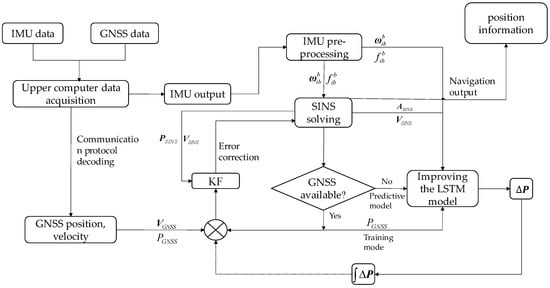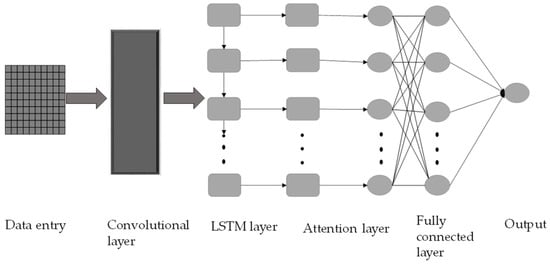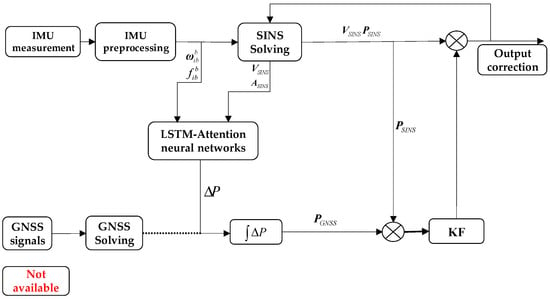Abstract
Aiming at the problem of the combined navigation system of on-board GNSS (global navigation satellite system)/SINS (strapdown inertial navigation system), the accuracy of the combined navigation system decreases due to the dispersion of the SINS over time and under the condition of No GNSS signals. An improved LSTM (long short-term memory) neural network in No GNSS signal conditions is proposed to assist the combination of navigation data and the positioning algorithm. When the GNSS signal is normal input, the current on-board combination of the navigation module’s output sensor data information is used for training to improve the LSTM algorithm and to establish the incremental output of the GNSS position of the mapping of the different weights. In No GNSS signal conditions, using the improved LSTM algorithm can improve the combination of navigation and positioning algorithms. Under No GNSS signal conditions, the improved LSTM training model is used to predict the dynamics of SINS information component data. Under No GNSS signal conditions, the combined navigation filtering design is completed, and the error correction of SINS navigation and positioning information is carried out to obtain a more accurate combination of navigation and positioning system accuracy. It can be seen through the actual test experiment using a sports car in the two trajectories under the conditions of No GNSS signals that the proposed algorithm can be compared with the LSTM algorithm. In testing road sections, the proposed algorithm, when compared with the LSTM algorithm to obtain the northward position that the mean square errors were improved by 55.63% and 76.64%, and the eastward position mean square errors were improved by 43.42% and 54.67%. In a straight-line trajectory, improving the effect’s navigation and positioning accuracy and reliability is significant.
1. Introduction
In recent years, with the rapid development of science and technology, means of communication, as well as geographic information, continue to mature, vehicle navigation applications are gradually improving, and vehicle high-precision navigation and positioning have become one of the basic needs of modern human life, with vehicle navigation systems reducing the impact of external environmental factors to reduce the occurrence of traffic accidents [,]. Vehicle position information is a key type of information in navigation and in the development of technical means such as in-vehicle navigation, driver assistance, autonomous driving, and intelligent transportation. High-precision vehicle positioning is the basis for vehicles to achieve path planning and motion-track tracking []. The use of GNSS and SINS sensors is currently a basic method of vehicle positioning; however, if used in a variety of complex driving environments such as buildings and tunnels, GNSS is prone to signal loss, which can lead to positioning being inaccurate or vehicles even being unable to receive positioning information. As a result, the positioning performance of in-vehicle GNSS navigation is unreliable in densely populated urban areas. In particular, the increasing number of elevated roads, tunnels, and other multi-layered traffic road structures make precise vehicle positioning even more difficult. Mis-matching of road layers often occurs in GNSS navigation systems, which can lead to irrational navigation commands, which can be a potential hazard and even a safety issue for drivers and pedestrians.
The random and integration errors of the inertial sensors and the onboard conditions of highly complex environmental information can lead to errors in the positioning accuracy of the combined GNSS/SINS navigation due to limited time. GNSS signals are easily affected by complex environments such as buildings and tunnels, and in this case, the lack of position and velocity information provided by GNSS in the combined navigation system leads to missing measurement information in the Kalman filter and the lack of measurement corrections. The combined navigation system then becomes a pure SINS solution under No GNSS signal conditions. This leads to rapid dispersion of navigation and positioning accuracy. Therefore, many scholars in China and abroad have conducted extensive research on combined navigation systems under No GNSS conditions, building models to assist combined navigation through neural networks and providing pseudo-GNSS information to suppress the dispersion of SINS navigation results.
Li X.Y et al. [] proposed a BP neural network-assisted combined navigation algorithm to improve the performance of a combined navigation system by using a BP neural network for online training to improve the position and velocity estimation accuracy of the combined navigation system and to enter the training mode under No GNSS signals to predict the position and velocity in real-time to obtain the position and velocity estimates to improve the performance and accuracy of combined navigation. This has been proven to be effective in terms of improving navigation accuracy under pure inertial navigation through in-vehicle measurements. Zhi et al. [] proposed a convolutional neural network-long and short time (CNN-LSTM)-based performance compensation method for GPS signal loss by building a CNN-LSTM network model and a wavelet. The LSTM network model and a wavelet threshold denoising algorithm were combined with the model algorithm. The improved model can effectively improve the performance of the combined navigation system when GPS is interrupted. Xu B et al. [] used a radial basis function-based neural network model (RBF) combined with volumetric Kalman filtering to assist the combined navigation and positioning system under No GNSS signals. The predictive model was used to correct the pure inertial guidance solution results under No GNSS signals to improve the navigation and positioning accuracy of their combined navigation system under No GNSS signals. Similarly, Sun W et al. [] modeled a radial basis function neural network. An improved K-means algorithm and a genetic algorithm were used to optimize the weight parameters of RBF neurons to improve the navigation positioning accuracy of their combined navigation system under No GNSS signals. However, the radial-based neural network model is prone to data sickness during the training process due to insufficient data work, which can lead to a sudden degradation in the performance of the predicted combined navigation results. Bai X et al. [] proposed an Elman neural network-assisted combined navigation federal filtering algorithm to ensure the stability and accuracy of combined navigation by correcting the position and velocity of the combined navigation system through Elman training when the satellite navigation signal is No or even out of range. The method uses the navigation results of inertial navigation as the network input and the position information of GNSS as the desired output for predictive corrections. A methodology for modelling the relationship between carrier attitude, velocity, MEMS sensor measurements and carrier position increments using multilayer perceptron neural network (MLPNN) to support combinatorial navigation []. In order to solve the problem that the pure inertial derivation diverges strongly when the GPS is out of lock, the gated recurrent unit (GRU)-assisted INS/GPS method is adopted [,]. A nonlinear autoregressive with external input (NARX) neural network assisted combinatorial navigation method is proposed []. A new Extreme Learning Machine (ELM) based GPS/INS intelligent structure for INS position error prediction and correction is proposed []. Modelling and prediction of GNSS accuracy from GNSS time series using machine learning techniques such as LSTM []. A recursive wavelet neural network (RWNN)-based algorithm is developed for data fusion in mobile SINS/GNSS systems, which significantly improves the overall navigation accuracy of low-cost SINS/GNSS systems []. Adaptive error damping coefficient based INS gives reliable navigation parameters during time intervals when GPS data is not available []. Fang Wei et al. [] proposed the use of a long short-term memory neural network (LSTM) to correct the error of navigation results relying on INS solutions under No GNSS signals so as to circumvent the problem of suppressing the performance accuracy of combined navigation due to pure INS divergence. In order to improve the positioning accuracy and performance of the combined navigation and positioning system in the time dimension, this paper adopts the LSTM neural network for the prediction processing, which makes good use of the advantages of this neural network in terms of real-time and correlation in the time dimension.
To address the training effect of the various neural network-assisted combined navigation algorithms mentioned above, this paper proposes an improved LSTM algorithm-assisted combined navigation method under No GNSS signals, which simulates the relationship between the dynamic information of the vehicle and navigation and positioning through an improved LSTM neural network-assisted combined GNSS/SINS navigation system modeling method under No GNSS signal conditions to improve the accuracy and reliability of combined navigation and positioning effects.
2. Relevant Basic Theory
2.1. Kalman Filtering
The Kalman filter algorithm is an optimization data processing algorithm proposed by mathematician Kalman [] and is widely used in many fields. The Kalman filter algorithm combines the current moment’s observations with the previous moment’s state update values by constructing a mathematical model to derive the current moment’s state update values.
Assume that the discretized equation of state for the system is
where and are the state vectors at moment k and k + 1, respectively; is the state transfer matrix of the system; is the system noise of the system at moment k.
The observation equation for the system is
where represents the system measurements at moment k + 1; is the observation matrix of the system at moment k + 1; is the measurement noise of the system at moment k + 1.
Denote by the optimal estimate at k moments . denote the optimal predicted value at k moments . Then, the Kalman filter recursive algorithm is as follows:
State prediction equation:
Covariance prediction equation:
Filter gain equation:
State estimating equation:
Filtered covariance update equation:
where is the covariance matrix of the forecast error estimates at moment k for moment k + 1.
By building a Kalman model, the Kalman filtering algorithm is used to iterate the system to achieve the estimation of the overall state information of the system.
2.2. Long- and Short-Term Memory Network LSTM Model
Long- and short-term memory networks are a type of recurrent neural network (RNN) [].
For a standard RNN neuron, the output equation is
where Wx is the weight of the input sampled at the current moment, Wh is the network output weight sampled at the previous moment, and b is a constant. To solve the problems of gradient loss and gradient explosion in traditional recurrent neural networks when dealing with long data sequences, LSTM proposes to introduce new concepts such as cells, input gates, forgetting gates, and output gates to solve the dependence of recurrent neural networks on long data sequences [].
The neurons in the LSTM neural network consist of “forgetting gates” , “input gates” and “output gates” , where the “forgetting gates” qualifies the input information from the previous point in time and forget it. The “input gate” selects a new input, while the “output gate” calculates the current output based on the new input and the previous output. The structure is shown in Figure 1.
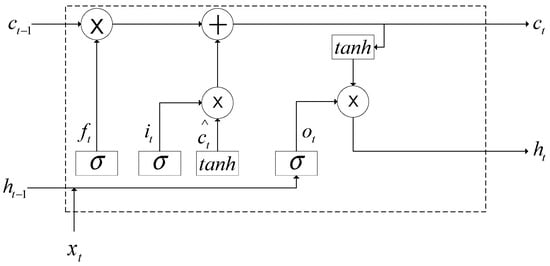
Figure 1.
LSTM structure diagram.
4. Algorithm Validation
4.1. Overview of On-Board Experiments
The combined navigation unit consists of an Inertial Measurement Unit (IMU) and an RTK antenna for the GNSS receiver. The combined navigation module is connected to the host PC (Personal Computer) through an RS232-to-USB serial data cable so that the IMU of the combined navigation module can receive acceleration and angular velocity information while the GNSS can output position and velocity information. Table 1 shows the performance parameters of the IMU, and Figure 6 shows the hardware environment of the combined navigation vehicle experiment and the vehicle experiment.

Table 1.
IMU equipment performance parameters.
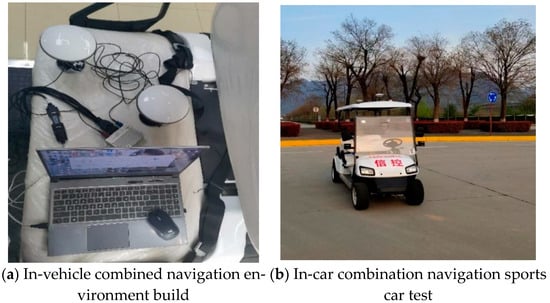
Figure 6.
As shown in the picture above. The left figure (a) shows the vehicle combination navigation sports car environment setup, and the right figure (b) shows the vehicle combination navigation actual test sports car experiment.
Using the combined navigation device, after making sure the wiring is correct, power up the system and make sure the operating voltage and current of all devices are within normal range; when the vehicle is at a standstill, first detect the working of GNSS receiving signal, then transmit the valid speed and position information to the inertial guidance system and use it as the initial value. Based on this, the inertial device at rest for 30 s is used to obtain its position information and achieve the initial alignment. The test vehicle is started up, and its navigation parameters are observed in real-time so that it is in maximum smooth motion. After the sports car has been tested, the output values of the combined navigation system IMU and GNSS in the case of real-time vehicle movement are stored via the upper computer data acquisition system to analyze the onboard data for positioning accuracy through an offline algorithm.
4.2. Onboard Offline Data Processing
The onboard offline data processing is carried out through an upper computer data acquisition system for the combined navigation system. The upper computer data acquisition system is connected to the PC through the RS232 and RS422 serial to USB serial communication data line from the combined navigation device. The general flow of the upper computer data acquisition system is shown in Figure 7.
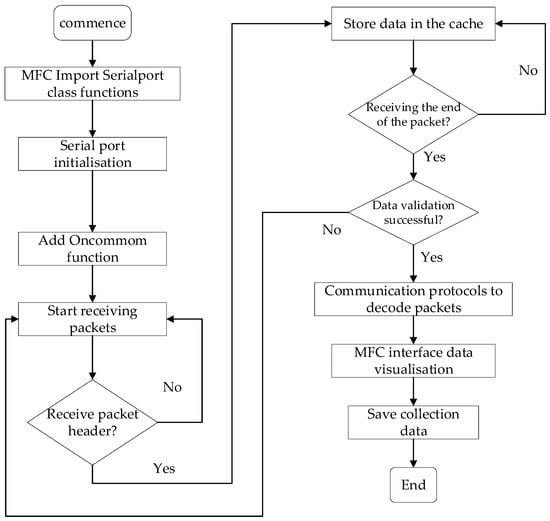
Figure 7.
General flowchart of the upper computer data acquisition system.
Considering the effect of real-time full-duplex communication, the serial port class function is introduced in the MFC (Microsoft Foundation Classes) interface to complete the upper computer acquisition system of the PC side and the in-vehicle combined navigation system, firstly to initialize the serial port and then to receive and solve the raw data output by the combined navigation system through the On-common function. As the data is transmitted in real-time, it is necessary to collect a complete set of data packets. After receiving the packet header of a set of data packets, the subsequent data of this set of data packets will be stored in the buffer until the end of the completely received packet tail data, after which the data put into the buffer will be checked, and if the check passes the communication protocol to decode the data packets, the data will be displayed visually in the MFC interface and then saved. Real-time data collection. This lays the foundation for subsequent research into the positioning algorithms of in-vehicle combined navigation systems.
4.3. Analysis of the Results of the On-Board Experiments
The pseudo-position information is predicted by the improved LSTM model algorithm in the case of signal loss within a short period, replacing the GNSS position information in the case of good signal, inputting it into the Kalman filter for optimal estimation, and correcting the SINS navigation error by the loose combination navigation algorithm to improve the performance of loose combination navigation under No GNSS conditions. The validity of the algorithm is verified by comparing the predicted values with the actual values through real experiments in a sports car.
The specific parameters of the improved LSTM algorithm are set:
By modeling the improved LSTM algorithm, it is determined that its input layers are set to 12 layers, 3-axis angular velocity, 3-axis acceleration, 3-axis velocity, and attitude angle a total of 12-dimensional feature vectors. Set up 2 layers of convolutional layer, activation function using RELU function, set up 1 layer of LSTM network layer; the initial learning rate is 0.006, learning rate descent factor is 0.1, add the attention layer, highlighting the impact of the key input dimensional feature vectors on the output, and finally carry out the dot-multiplication fully-connected layer for the output, the maximum number of training times is set to 300, the optimization algorithm adopts the learning rate adaptive Adam gradient descent algorithm [,,].
In Xi’an University of Architecture and Technology (XUAST) Cao Tang campus for 800 s of sports car measurement experiments, sports car trajectory as shown in Figure 8, the red trajectory for the vehicle measured trajectory, the black trajectory for the IMU sensor solved trajectory, due to the SINS solved trajectory error is too large, so the use of the combination of SINS/GNSS navigation trajectory and the vehicle measured trajectory for comparison, the comparison of trajectory as shown in Figure 9. There are two sections in Figure 9 for GNSS signal shielding processing, experimental Section 1 and experimental Section 2 are the 60 s and 42 s, respectively, for two time periods on the GNSS information collected by the host computer data acquisition system, to achieve the effect of the existence of a No GNSS signal condition in the period.
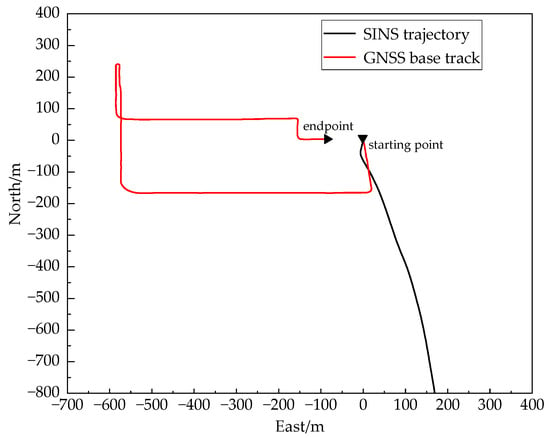
Figure 8.
GNSS reference trajectory and SINS trajectory.
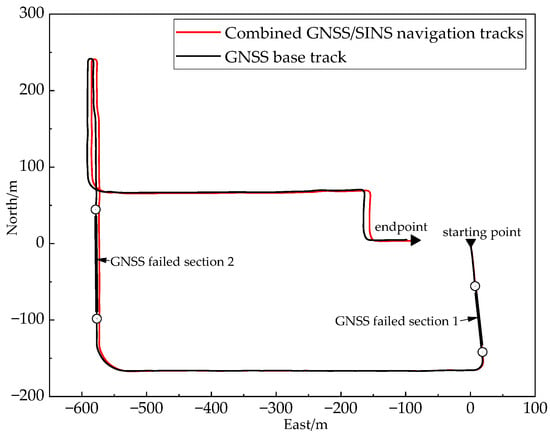
Figure 9.
Combined GNSS/SINS navigation trajectory and GNSS reference trajectory.
GNSS Failure Section 1: No GNSS signal processing is carried out in the track Section 1. This experimental Section 1 is used to simulate the No GNSS signal conditions in the onboard complex environment by using the data acquisition system of the upper computer to process the data collected by the GNSS receiver offline in the time from 50 s to 110 s.
Figure 10 shows the comparison between the trajectories of the three different algorithms and the benchmark trajectory under the No GNSS signal conditions in the experimental road Section 1, and it can be seen from Figure 10 that under the No GNSS signal conditions in road Section 1, the predicted trajectory of the improved LSTM algorithm proposed in this paper is closer to the real benchmark trajectory, To make a clear comparison, this paper also carries out the eastward position error comparison and northward position error comparison analysis of three different algorithms, and the position error comparison analysis is shown in Figure 11 and Figure 12. The position error values are analyzed through the data of different algorithm comparison experiments to further verify the feasibility of the algorithm in this paper.
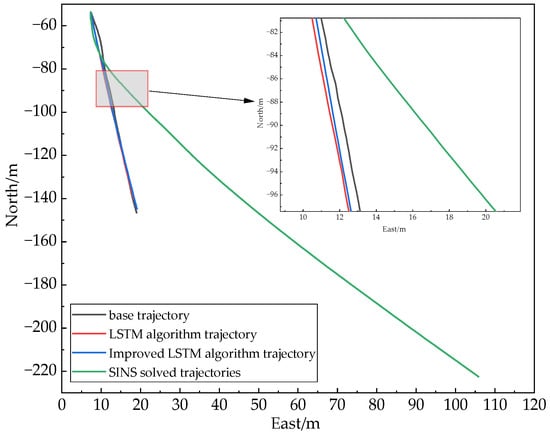
Figure 10.
Comparison of trajectories of each algorithm under 60 s No GNSS signal condition.

Figure 11.
Comparison of eastward position error of each algorithm under 60 s No GNSS signal condition.
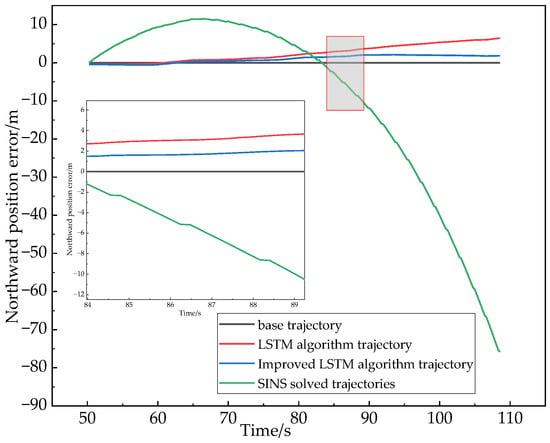
Figure 12.
Comparison of northward position error of each algorithm under 60 s No GNSS signal condition.
In experimental Section 1, in the time from 50 s to 110 s, the use of the host computer data acquisition system on the GNSS receiver collected data offline processing to achieve the simulation of the vehicle complex environment of No GNSS signal conditions, Figure 11 and Figure 12 show the position error comparison of the three algorithms in 60 s No GNSS signal conditions, the results show in the first experimental section of the No GNSS signal process, the positioning accuracy of the three positioning methods will have different errors, and the improved LSTM neural network assisted combined navigation algorithm used in this paper has a higher positioning accuracy than that of LSTM with SINS. In the whole movement state, the maximum error absolute value, the root mean square error, is selected for data analysis to reflect the change of data before and after the improved algorithm. From Figure 11 and Figure 12, we can see that the improved LSTM algorithm is better than the other algorithms in terms of the root mean square error and the maximum absolute error under the whole motion state.
From the position error analysis table derived from Table 2, we can obtain the comparative analysis of the maximum error of the eastward position; the accuracy of the improved LSTM algorithm is improved by 5.03% over the LSTM algorithm and 98.91% over the pure SINS solution. Comparative analysis of the root mean square error of the eastward position, the accuracy of the improved LSTM algorithm is improved by 43.42% over the LSTM algorithm and 98.88% over the pure SINS solution. For the comparative analysis of the maximum error of the northward position, the accuracy of the improved LSTM algorithm is improved by 66.64% over the LSTM algorithm and 98.29% over the pure SINS solution. Comparative analysis of the root mean square error of the northward position, the accuracy of the improved LSTM algorithm is improved by 55.63% over the LSTM algorithm and 95.98% over the pure SINS solution.

Table 2.
Comparison of statistical parameters of different neural networks under 60 s No GNSS signal conditions.
GNSS Failure Section 2: No GNSS signal processing is carried out in the track Section 2. In experiment Section 2, the data collected by the GNSS receiver is processed offline by using the data acquisition system of the upper computer in the time from 380 s to 422 s to achieve the simulation of the No GNSS signal conditions in the onboard complex environment.
Figure 13 shows the comparison between the trajectories of the three different algorithms and the benchmark trajectory under the No GNSS signal conditions in the experimental Section 2. It can be seen from Figure 13 that the trajectories predicted by the improved LSTM algorithm proposed in this paper are closer to the real benchmark trajectory under the No GNSS signal conditions in Section 2. To make a clear comparison, this paper also carries out the position error comparison of three different algorithms in the east direction and the position error comparison in the north direction, and the position error comparison analysis is shown in Figure 14 and Figure 15. The position error values are analyzed through the data of different algorithm comparison experiments to further verify the feasibility of the algorithm in this paper.
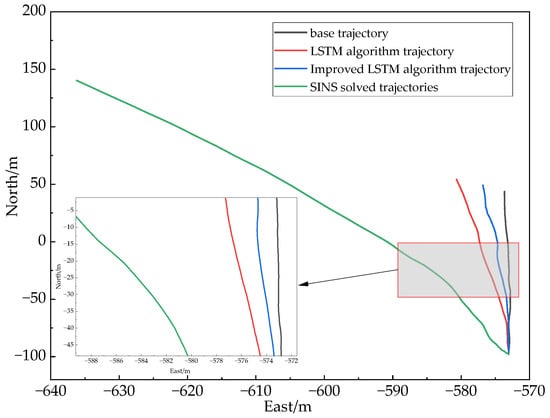
Figure 13.
Comparison of trajectories of each algorithm under 42 s No GNSS signal condition.
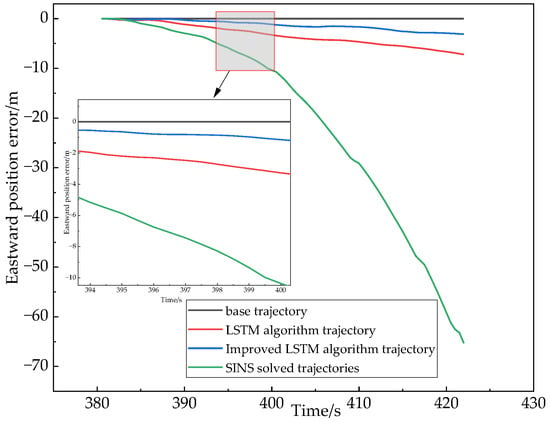
Figure 14.
Comparison of the eastward position errors of the algorithms under 42 s No GNSS signal conditions.
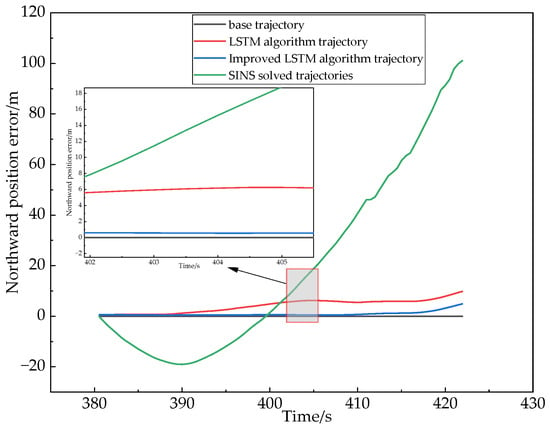
Figure 15.
Comparison of the northward position errors of the algorithms under 42 s No GNSS signal conditions.
In this experimental Section 2 in the time from 380 s to 422 s, the use of the host computer data acquisition system on the GNSS receiver collected data for offline processing to achieve the simulation of the vehicle’s complex environment under the conditions of No GNSS signals, Figure 14 and Figure 15 show the position error comparison of the three algorithms in the 42 s No GNSS signal conditions, the results show that in the second experimental section of No GNSS signals process, the positioning accuracy of the three positioning methods will have different errors, and the improved LSTM neural network-assisted combined navigation algorithm used in this paper has a higher positioning accuracy than that of LSTM with SINS. In the whole movement state, the maximum error absolute value and the root mean square error are selected for data analysis to reflect the change of data before and after the improved algorithm. From Figure 14 and Figure 15, we can see that the improved LSTM algorithm is better than the other algorithms in terms of the root mean square error and the maximum absolute error under the whole motion state.
From the position error analysis table derived from Table 3, we can obtain the comparative analysis of the maximum error of the eastward position; the accuracy of the improved LSTM algorithm is improved by 56.82% over the LSTM algorithm and 95.21% over the pure SINS solution. Comparative analysis of the root mean square error of the eastward position, the accuracy of the improved LSTM algorithm is improved by 54.67% over the LSTM algorithm and 95.01% over the pure SINS solution. Comparative analysis of the maximum error of the northward position, the accuracy of the improved LSTM algorithm is improved by 48.15% over the LSTM algorithm and 94.72% over the pure SINS solution. For the comparative analysis of the root mean square error of the northward position, the accuracy of the improved LSTM algorithm is improved by 76.64% over the LSTM algorithm and 97.26% over the pure SINS solution.

Table 3.
Comparison of statistical parameters of different neural networks under 42 s No GNSS signal conditions.
The reliability and superiority of the improved LSTM algorithm-assisted GNSS/SINS loose-combination navigation algorithm under No GNSS signals for a short period is verified by 2 in a smooth, straight-line driving trajectory section.
5. Conclusions
Aiming at the problem that GNSS signals are easily lost, or No GNSS signals exist due to the complex in-vehicle navigation road environment under the algorithm research of combined in-vehicle GNSS/SINS navigation system, an improved LSTM algorithm is proposed to assist the combined in-vehicle GNSS/SINS navigation and positioning algorithm. The method solves the problem that navigation information can affect the accuracy and precision of in-vehicle navigation when it is provided by the SINS system only, which can easily cause excessive position deviation and improve the accuracy and performance of combined navigation under No GNSS conditions.
The experiments in a real environment of a sports car show that in two No GNSS signal conditions, the root mean square error of the eastbound position is improved by 43.42% and 54.67% compared with the LSTM algorithm, and the root mean square error of the northbound position is improved by 55.63% and 76.64% compared with the LSTM algorithm, respectively, which verifies the effectiveness and feasibility of the algorithm.
Shortcomings: This article is only GNSS/SINS loose combination navigation mode research, can only be in the No GNSS signal conditions of a short period through the improved LSTM algorithm to assist the combination of navigation algorithms for offline vehicle navigation and positioning research, and the algorithm is currently the research situation only applies to the smooth straight-line trajectory. The real-time positioning of high-precision vehicle navigation in complex environments still requires further research and analysis and can be used in the way of multi-sensor fusion to carry out long-time positioning research of vehicle navigation.
Author Contributions
Writing—review and editing, resources, supervision, L.S.; conceptualization, methodology, validation, formal analysis, writing—original draft, P.X.; supervision formal analysis, X.H.; supervision investigation Y.L. supervision visualization J.H. and H.F. All authors have read and agreed to the published version of the manuscript.
Funding
This study was supported by a grant from the Equipment Major Basic Research Project of the Equipment Development Department of the Central Military Commission of China under Grant (2018921007). And a grant from the Key Laboratory of National Defence Science and Technology Fund under Grant (2021-JCJQ-LB-070-08).
Institutional Review Board Statement
Not applicable.
Data Availability Statement
The raw/processed data required to reproduce these findings cannot be shared at this time as the data also form part of an ongoing study.
Conflicts of Interest
The authors declare no conflict of interest.
References
- Lai, L.; Zhao, D.; Xu, T.; Cheng, Z.; Guo, W.; Li, L. Improving Vehicle Positioning Performance in Urban Environment with Tight Integration of Multi-GNSS PPP-RTK/INS. Remote Sens. 2022, 14, 5489. [Google Scholar] [CrossRef]
- Dörterler, M.; Faruk Bay, Ö. Neural Network Based Vehicular Location Prediction Model for Cooperative Active Safety Systems. Promet-Traffic Transp. 2018, 30, 205–215. [Google Scholar] [CrossRef]
- Wang, J.; Song, H.; Jing, Q.; Liu, K. Road-range Tracking of Vehicle Trajectories Based on Millimeter-wave Radar. Chin. J. Highw. 2022, 35, 181–192. [Google Scholar]
- Li, X.Y.; Li, J.; Feng, K.Q.; Yang, Y.; Chao, Z. Research on Integrated Navigation Algorithm Based on BP Neural Network. Electron. Devices 2018, 41, 1447–1451. [Google Scholar]
- Zhi, Z.; Liu, D.; Liu, L. A performance compensation method for GPS/INS integrated navigation system based on CNN–LSTM during GPS outages. Measurement 2022, 188, 110516. [Google Scholar] [CrossRef]
- Xu, B.; Li, S.; Jin, K.; Wang, L. A Cooperative Localization Method for AUVs Based on RBF Neural Network-assisted CKF. J. Mil. Eng. 2019, 40, 2119–2128. [Google Scholar]
- Sun, W.; Cao, H.Y. KPCA/Improved RBF neural network aided GPS/UWB cooperative positioning method. J. Navig. Position. 2022, 10, 112–121. [Google Scholar]
- Bai, X.; Yang, J.; Yang, Z. Research on neural network-assisted integrated navigation algorithm. J. Navig. Position. 2020, 8, 93–98. [Google Scholar]
- Fang, W.; Jiang, J.G.; Xie, D.P. Improved integrated navigation algorithm based on MLP neural network. Comput. Eng. Des. 2021, 42, 65–69. [Google Scholar]
- Tao, Y.; Jiang, J.; Fang, W. Integrated navigation algorithm based on GRU cyclic neural network. Comput. Eng. Des. 2021, 42, 370–376. [Google Scholar]
- Xu, S.; Petrunin, I.; Tsourdos, A. Experimental Evaluation of GNSS and IMU Fusion Using Gated Recurrent Unit. In Proceedings of the 2022 Integrated Communication, Navigation and Surveillance Conference (ICNS), Dulles, VA, USA, 5–7 April 2022; pp. 1–8. [Google Scholar]
- Zhang, S.; Zheng, L.; Hou, P. Integrated Navigation Method Based on NARX Neural Network. Meas. Control Technol. 2022, 41, 119–125. [Google Scholar]
- Li, D.; Jia, X.; Zhao, J. A Novel Hybrid Fusion Algorithm for Low-Cost GPS/INS Integrated Navigation System during GPS Outages. IEEE Access 2020, 8, 53984–53996. [Google Scholar] [CrossRef]
- Gao, W.; Li, Z.; Chen, Q.; Jiang, W.; Feng, Y. Modelling and prediction of GNSS time series using GBDT, LSTM and SVM machine learning approaches. J. Geod. 2022, 96, 71. [Google Scholar] [CrossRef]
- Rafatnia, S.; Nourmohammadi, H.; Keighobadi, J.; Badamchizadeh, M.A. In-move aligned SINS/GNSS system using recurrent wavelet neural network (RWNN)-based integration scheme. Mechatronics 2018, 54, 155–165. [Google Scholar] [CrossRef]
- Stancic, R.; Graovac, S. The integration of strap-down INS and GPS based on adaptive error damping. Robot. Auton. Syst. 2010, 58, 1117–1129. [Google Scholar] [CrossRef]
- Fang, W.; Jiang, J.; Lu, S.; Gong, Y.; Tao, Y.; Tang, Y.; Yan, P.; Luo, H.; Liu, J. A LSTM Algorithm Estimating Pseudo Measurements for Aiding INS during GNSS Signal Outages. Remote Sens. 2020, 12, 256. [Google Scholar] [CrossRef]
- Peng, D. Pseudo-linear Kalman Filter in Passive Target Tracking. Softw. Guide 2009, 8, 32–34. [Google Scholar]
- Yang, L.; Wu, Y.X.; Wang, J.L.; Liu, Y.L. Research on recurrent neural network. Comput. Appl. 2018, 38, 1–6+26. [Google Scholar]
- Peng, W.; Wang, J.R.; Yin, S.Q. Short-term Load Forecasting Model Based on Attention-LSTM in Electricity Market. Pow. Technol. 2019, 43, 1745–1751. [Google Scholar]
- Li, M.; Ning, D.; Guo, J. Attention Mechanism-Based CNN-LSTM Model and Its Application. Comput. Eng. Appl. 2019, 55, 20–27. [Google Scholar]
- Ye, X.; Ye, Q.; Yan, X.; Wang, T.; Chen, J.; Li, S. Demand Forecasting of Online Car-Hailing with Combining LSTM + Attention Approaches. Electronics 2021, 10, 2480. [Google Scholar] [CrossRef]
Disclaimer/Publisher’s Note: The statements, opinions and data contained in all publications are solely those of the individual author(s) and contributor(s) and not of MDPI and/or the editor(s). MDPI and/or the editor(s) disclaim responsibility for any injury to people or property resulting from any ideas, methods, instructions or products referred to in the content. |
© 2023 by the authors. Licensee MDPI, Basel, Switzerland. This article is an open access article distributed under the terms and conditions of the Creative Commons Attribution (CC BY) license (https://creativecommons.org/licenses/by/4.0/).
